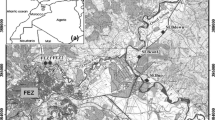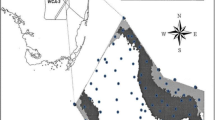Abstract
Soil and water samples were analysed for trace metals and As in two watercourses and 14 sampling plots in a salt marsh polluted by mine wastes in SE Spain. Groundwater levels, soil pH and Eh were measured ‘in situ’ for a 12-month period in each sampling plot, and total calcium carbonate was also determined. Low concentrations of soluble metals (maximum Mn 1.089 mg L−1 and maximum Zn 0.553 mg L−1) were found in the watercourses. However, total metal contents were extremely high in the soils of a zone of the salt marsh (maximum 1,933 mg kg−1 of Mn, 62,280 mg kg−1 of Zn, 16,845 mg kg−1 of Pb, 77 mg kg−1 of Cd, 418 mg kg−1 of Cu and 725 mg kg−1 of As), and soluble metals in the pore water reached 38.7 mg L−1 for Zn, 3.15 mg L−1 for Pb, 48.0 mg L−1 for Mn, 0.61 mg L−1 for Cd and 0.29 mg L−1 for As. Variable concentrations with depth indicate a possible re-mobilisation of the metals, which could be related to spatial and temporal variations of water table level, pH and Eh and to the presence of calcium carbonate. A tendency for the Eh to decrease in the warmest months and to increase in the coldest ones was found, especially, in plots that received water with a high content of dissolved organic carbon. Hence, the existence of nutrient effluent-enriched water may modify the physical–chemical conditions of the soil–water system and influence metal mobility.








Similar content being viewed by others
References
Álvarez-Rogel, J., Jiménez-Cárceles, F. J., & Egea, C. (2006). Phosphorus and nitrogen content in the water of a coastal wetland in the Mar Menor lagoon (SE Spain): Relationships with effluents from urban and agricultural areas. Water, Air and Soil Pollution, 173, 21–38.
Álvarez-Rogel, J., Ramos, M. J., Delgado, M. J., & Arnaldos, R. (2004). Metals in soils and above-ground biomass of plants from a salt marsh polluted by mine wastes in the coast of the Mar Menor lagoon, SE Spain. Fresenius Environmental Bulletin, 13, 274–278.
Auernheimer, C., Chinchon, S., & Pina, J. A. (1996). Lead pollution inn bivalve shells. Mar Menor, Spain. Arch. Sc. Genève, 49, 87–98.
Carbonell-Barrachina, A. A., Jugsujinday, A., Burlo, F., DeLaune, R. P., & Patrick Jr., W. H. (1999). Arsenic chemistry in municipal sewage sludge as affected by redox potential and pH. Water Research, 34, 216–224.
Carbonell-Barrachina, A. A., Rocamora, A., García-Gomis, C., Martínez-Sánchez, F., & Burló, F. (2004). Arsenic and zinc biogeochemistry in pyrite mine waste from the Aznalcóllar environmental disaster. Geoderma, 122, 195–203.
Cheng, S., Grosse, W., Karrenbrock, F., & Thoennessen, M. (2002). Efficiency of constructed wetlands in decontamination of water polluted by heavy metals. Ecological Engineering, 18, 317–325.
Conesa, H. M., & Jiménez-Cárceles, F. J. (2007). The Mar Menor lagoon (SE Spain): A singular natural ecosystem threatened by human activities. Marine Pollution Bulletin, DOI 10.1016/j.marpolbul.2007.05.007.
Conesa, H. M., Robinson, B. H., Schulin, R., & Nowack, B. (2007). Growth of Lygeum spartum in acid mine tailings: Response of plants developed from seedlings, rhizomes and at field conditions. Environmental Pollution, 145, 700–707.
García-Pintado, J., Martínez-Mena, M., Barberá, G. G., Alvadalejo, J., & Castillo, V. M. (2007). Anthropogenic nutrient sources and loads from a Mediterranean catchment into a coastal lagoon: Mar Menor, Spain. The Science of the Total Environment, 373, 220–239.
Huerta-Díaz, M. A., & Morse, J. W. (1992). Pyritization of trace metals in anoxic marine sediments. Geochimica et Cosmochimica Acta, 56, 2681–2702.
Jacob, D. L., & Otte, M. L. (2003). Conflicting processes in the wetland plant rhizosphere: Metal retention or mobilization? Water, Air and Soil Pollution, 3, 91–104.
Jiménez-Cárceles, F. J., Egea, C., Rodríguez-Caparrós, A. B., Barbosa, O. A., Delgado, M. J., Ortiz, R., & Álvarez-Rogel, J. (2006). Contents of nitrogen, ammonium, phosphorus, pesticides and heavy metals, in a salt marsh on the coast of the Mar Menor lagoon (SE Spain). Fresenius Environmental Bulletin, 15(5), 370–378.
Kirk, G. (2004). The biogeochemistry of submerged soils. Chichester: Wiley.
Marín-Guirao, L., Marín, A., Lloret, J., Martínez-López, E., & García-Fernández, A. J. (2005). Effects of mining wastes on a seagrass ecosystem: Metal accumulation and bioavailability, seagrass dynamics and associated community structure. Marine Environmental Research, 60, 317–337.
Mays, P. A., & Edwards, G. S. (2001). Comparison of heavy metal accumulation in a natural wetland and constructed wetlands receiving acid mine drainage. Ecological Engineering, 16, 487–500.
Masscheleyn, P. H., & Patrick, W. H. Jr. (1994). Selenium, arsenic and chromium redox chemistry in wetland soils and sediments. In D. C. Adriano, Z. S. Chen, & S. S. Yang (Eds.), Biogeochemistry of trace elements. (pp. 615–625). Georgia.
Morse, J. W. (1994). Interactions of trace metals with authigenic sulphide minerals: Implications for their bioavailability. Marine Chemistry, 46, 1–6.
O’Sullivan, A. D., Murray, D. A., & Otte, M. L. (2000). Rehabilitating mine tailings water using constructed wetlands. In D. W. Lee, & S. G. Richarson (Eds.), 17th Annual meeting for the surface mining and reclamation: A new era for land reclamation. Proceedings of the international meeting of the American Society for Surface Mining and Reclamation (pp. 438–445). Tampa, Florida.
Otero, X. L., Huerta-Diaz, M. A., & Macías, F. (2000). Heavy metal geochemistry of saltmarsh soils from the Ría of Ortigueria (mafic and ultramafic areas, NW Iberian Peninsula). Environmental Pollution, 110, 285–296.
Otero, X. L., & Macías, F. (2001). Soil phase iron in high salt marsh soils in relation to redox potential. Fresenius Environmental Bulletin, 10, 674–678.
Otero, X. L., & Macías, F. (2002). Spatial and seasonal variation in heavy metals in interstitial water of salt marsh soils. Environmental Pollution, 120, 183–190.
Otero, X. L., & Macías, F. (2003). Spatial variation in pyritization of trace metals in salt-marsh soils. Biogeochemistry, 62, 59–86.
Robles-Arenas, V. M., Rodríguez, R., García, C., Manteca, J. I., & Candela, L. (2006). Sulphide-mining impacts in the physical environment: Sierra de Cartagena-La Unión (SE Spain) case study. Environmental Geology, 51, 47–64.
Van den Berg, G. A., Gustav, J. P., Van der Heijdt, L. M., & Zwosman, J. J. G. (1999). Mobilisation of heavy metals in contaminated sediments in the river Meuse, The Netherlands. Water, Air and Soil Pollution, 116, 567–586.
Vepraskas, M. J., & Faulkner, S. P. (2001). Redox chemistry of hidrics soils. In J.L. Richarson, & M.J. Vepraskas (Eds.)Wetland soils (pp. 85–107). Florida: Lewis Publishers.
Acknowledgments
Support for this research was provided by the Ministerio de Ciencia y Tecnología of Spain (REN 2001–2142). H. M. Conesa has a post-doctoral grant supported by the Fundación Séneca-Agencia de Ciencia y Tecnología of the Comunidad Autónoma de la Región de Murcia (Spain). F.J. Jiménez-Cárceles had a grantee financed by the Caja Mediterráneo (CAM). We also thank J. Mari Belchí from the Language Service of the Universidad Politécnica de Cartagena, and Dr. David J. Walker from Institute for Research and Agrarian Development of Murcia (IMIDA-Murcia) for improving the English translation. Finally, we acknowledge the valuable collaboration and efficiency of A. Belen Rodríguez-Caparrós, from the Servicio de Apoyo a la Investigación (SAIT) of the Universidad Politécnica de cartagena, in the management of the ICP-MS and TOC-VCSH equipments.
Author information
Authors and Affiliations
Corresponding author
Rights and permissions
About this article
Cite this article
Jiménez-Cárceles, F.J., Álvarez-Rogel, J. & Conesa Alcaraz, H.M. Trace Element Concentrations in Saltmarsh Soils Strongly Affected by Wastes from Metal Sulphide Mining Areas. Water Air Soil Pollut 188, 283–295 (2008). https://doi.org/10.1007/s11270-007-9544-4
Received:
Accepted:
Published:
Issue Date:
DOI: https://doi.org/10.1007/s11270-007-9544-4




